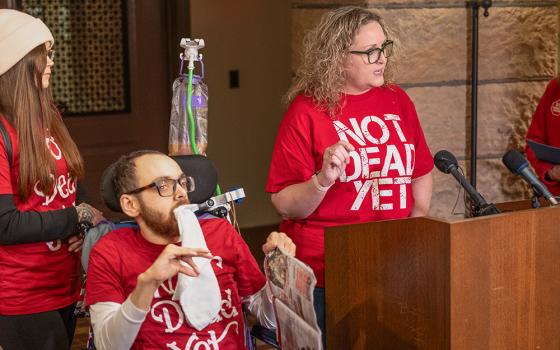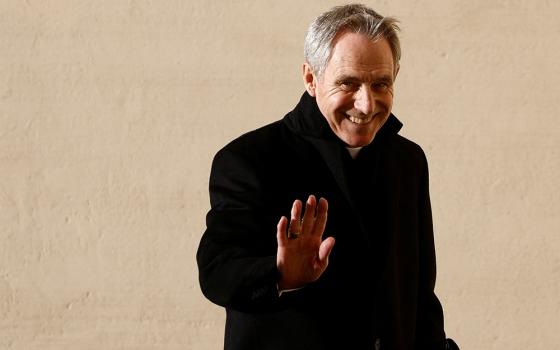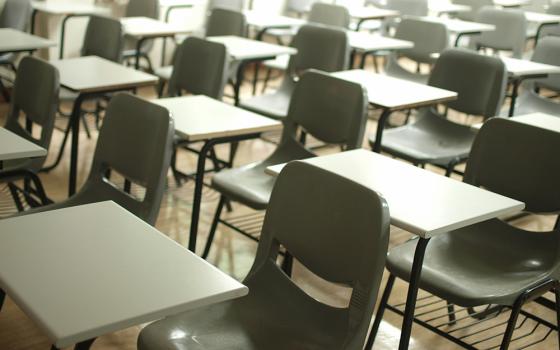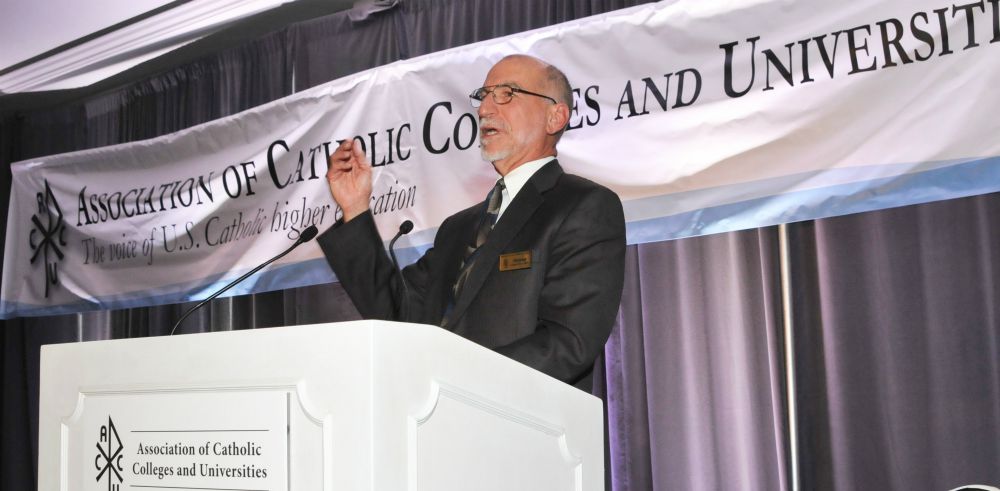
Michael Galligan-Stierle, Association of Catholic Colleges and Universities president and CEO, addresses the annual meeting. (Courtesy of ACCU/Peter Cutts)
The landscape of Catholic higher education is changing, but the benefit it offers to students and the world is unmistakable, concluded this year's Association of Catholic Colleges and Universities (ACCU) annual meeting held here Feb. 3-5.
"We've been at this for a while now, and we certainly know how to do this," Michael Galligan-Stierle, Association of Catholic Colleges and Universities president and CEO, declared at the beginning of the meeting's last panel Feb. 5.
"And we're really good at it, because we've been at it [so] long, and our schools share best practices with one another," he added, stressing the importance of cooperation between Catholic educational institutions, a theme that arose frequently throughout the meeting. "There are other reasons why we're good at this. These are two; there's a lot more," Galligan-Stierle said.
The annual gathering sometimes took sobering turns in discussions about institutions that have recently or may soon face serious financial trouble and even closure as the pool of potential traditional college students is shrinking and technological advances threaten the status quo in higher education. Galligan-Stierle noted that as Catholic schools are developing ways to confront new challenges, they continue to have clear positive effects.
Galligan-Stierle's speech came the morning after Newark* Cardinal Joseph Tobin addressed the conference, discussing how three themes of Pope Francis' papacy — encounter, accompany, and dialogue — apply to the mission of Catholic higher education.
"Francis understands that to arrive at 'encounter,' the church itself must undergo a paradigm shift, to cease being what he calls 'self-referential,' or perhaps we could say, 'self-centered,' " Tobin said.
Advertisement
Drawing on Tobin's talk, Jesuit Fr. Stephen Sundborg, president of Seattle University, reminded those from Catholic colleges and universities not to "give more effort to self-preservation than to education of students," noting that during his tenure as president he has seen increasing time devoted to the former at the expense of the latter. Academics are ultimately what define a university, and focusing on the mission of educating the full person is the way to keep Catholic institutions relevant, he said.
From Galligan-Stierle's words, it seems that Catholic colleges and universities are doing just that; they "have more women leaders as presidents than any other cohort that exists," he said, adding that students at ACCU member schools "are the top of the game in terms of doing service not only during college, but after they graduate," and are also significantly more likely than their counterparts at other institutions to discuss ethics in class and, surveys show, take those lessons to heart.
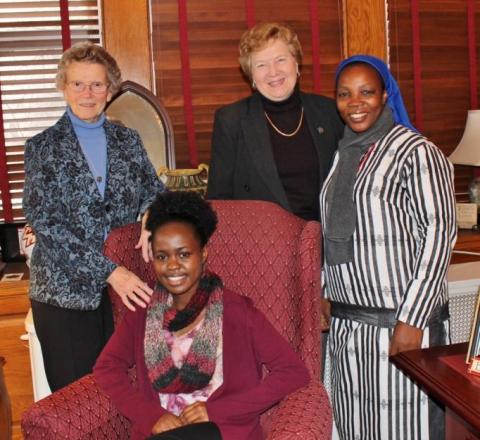
St. Joseph Sr. Kathryn Miller, Chestnut College President St. Joseph Sr. Carol Jean Vale, and Sr. Helen Imhandeyo Alekhuojie, a Sister Servant of the Most Sacred Heart pose standing at a Chestnut College meeting in 2016. Seated is Mercy Thuranira, a student from Ghana, who also joined the meeting. (Courtesy of Chestnut Hill College/Marilee Gallagher)
Chestnut Hill College president St. Joseph Sr. Carol Jean Vale focused her remarks on the changes and decisions leaders in Catholic higher education need to make in the coming months and years. Changes in technology are opening new opportunities, and educators cannot be left behind.
"Cyberspace is the air they [students] breathe, while we [administrators] need digital oxygen tanks," she said, also noting that "there is concern for faculty competence in the digital world," suggesting her colleagues should hire staff to continually educate faculty on the changes in technology.
"What skills and competencies do our students need to be successful in the 21st century?" Vale asked, highlighting the imperative to educate students to distinguish "fake news" from the truth, as well as determining the future of academics.
Administrators must identify "the disciplines where growth is probable, and how… they compare with our current majors," she said, adding "it is obvious [Catholic colleges and universities] cannot continue to do things the way they've always been done. … Which are the majors that need to be eliminated, which need to be expanded, which need to be offered in a different way?"
It would appear that Catholic universities are on the right track adapting to many of the issues Vale raised. The vast majority, over 90 percent, of students at Catholic colleges and universities receive financial aid, and the average financial award amount is about $19,000, Galligan-Stierle said. He also noted the high rates of socio-economic mobility students see after graduation, as well as their higher rates of pay.
Graduates from Catholic institutions also face a smaller debt burden after graduation, around $25,000 when the national average is about $35,000, and are far more likely to pay their loans back.
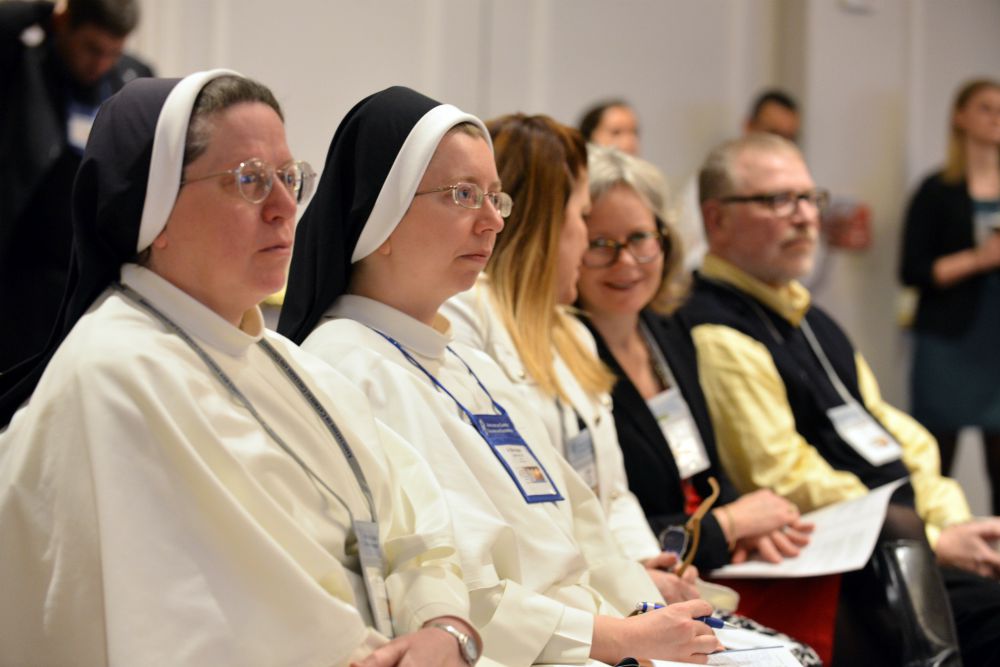
Participants at the 2017 annual meeting of the Association of Catholic Colleges and Universities (Courtesy of ACCU/Peter Cutts)
"Part of the reason education can cost so much is because it takes five or six years to [graduate]. The worst thing that could happen is someone does one two or three years and doesn't get to the finish line. That debt is enormous if you don't have that credential," Galligan-Stierle said, noting that Catholic educated students tend to graduate in a shorter timespan than their counterparts at other universities.
While the challenges are undeniable, for Catholic colleges and universities, their ability to adapt and remain successful is also clear. "It was nice to see that some of the steps we've taken were the ones that were being affirmed at the meeting," Andrew Manion, president of Marian University in Fond du Lac Wisconsin, told NCR.
"We have been expanding to serve adult students for a number of years now, and we have developed some online programs we are in the process of expanding as well, and so we're cognizant of the changing demographics regarding high school graduation rates," he said, noting that Marian University had enrolled the largest class of first-year students in its history, more than 350 people for the 2017-18 academic year.
While some at the conference used the language of redefining or expanding the mission of small Catholic colleges, "redefining your Catholicity, or redefining the charism of the order that sponsors you … that, to me, is off the table," Manion said. "Your mission is your mission." Instead, he believes that a better expression of what needs to be reconsidered is institutions' "audiences" as demographics change along with the pool of potential students.
Despite the darker turns the conversation took at times, the meeting ended with a positive message.
"You folks are doing a fabulous job," Galligan-Stierle told the crowd of Catholic college and university administrators, "and we need to find a way to keep getting positive messages out there,"
*This story has been corrected to reflect that Cardinal Tobin is the archbishop of Newark, not Indianapolis as a previous version of the article stated.
[James Dearie is an NCR Bertelsen intern. Contact him at jdearie@ncronline.org.]






